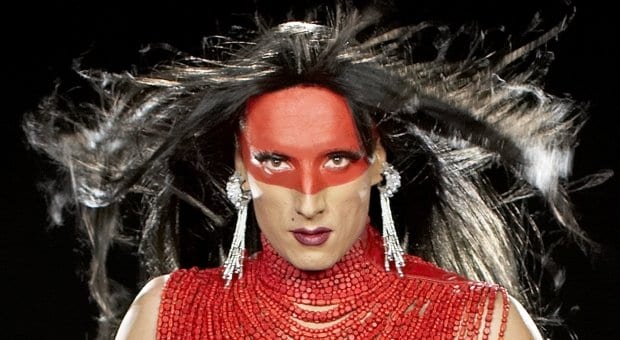If the phrase “native art” conjures visions of stately totem poles and delicate animal etchings, Beat Nation will prove eye opening. First presented at the Vancouver Art Gallery in 2012 by co-curators Kathleen Ritter and Tania Willard, the show not only dismantles conventional notions of “native art” — it questions whether the term should even be used.
“I don’t think you can say ‘native art’ anymore,” Willard says. “It’s a misnomer to begin with because aboriginal expression is as diverse as our languages and cultures. Art is great when it’s a surprise and makes us think in new ways. Those who hold such stereotypes of native art will be surprised to reconsider the label in the wake of artists working in spray paint, digital music and DJ culture.”
Juxtaposing aboriginal identity with urban youth culture, the show features nearly two dozen artists blending and remixing cultures, with several queer and two-spirited voices.
“We discussed ideas of heterosexuality and gender discrimination in mainstream hip hop and wanted to make sure we focused on the genre’s more diverse and conscious voices,” Willard says. “Indigenous cultures have recognized many forms of gender, and we tried to honour this in the exhibition by including artists who fall into other categories of gender or sexuality.”
Kent Monkman’s Dance to Miss Chief was a natural fit for the exhibition. Conceived as a music video for his performance character Miss Chief Eagle Testickle’s first dance track, the video blends Monkman’s earlier work Dance to the Berdashe with scenes from German Westerns (an obscure film genre celebrating the country’s obsession with America’s Wild West).
Usually appearing nearly nude, save for platform heels and a feather headdress, the outrageous Miss Chief (or “mischief” depending on your pronunciation) represents both an intersection of traditional aboriginal cultures and contemporary gay identity and a reversal of the objectifying gaze cast on native peoples by Europeans. She first appeared in one of Monkman’s paintings, but she’s expanded her oeuvre to film and live performance. A music video seemed a natural, if humorous, next step.
“I wanted to play with the idea of creating a music video for this manufactured celebrity who has no real talent,” Monkman says. “I’ve thought of expanding her merchandising dreams to include a fragrance, like other mock celebrities trying to squeeze money from their fame. But I’d rather focus on her political stance.”
Beat Nation: Art, Hip Hop and Aboriginal Culture
Runs until Sun, Jan 5
Musée D’art Contemporain de Montréal
185 Ste-Catherine St W, Montreal


 Why you can trust Xtra
Why you can trust Xtra


